
Concept explainers
Draw the products formed in each reaction.
a.  e.
e. 
b.  f.
f. 
c.  g.
g. 
d.  h.
h. 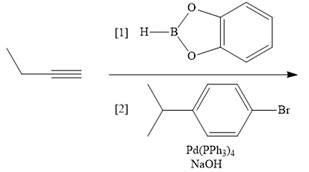
(a)
Interpretation: The product formed in the given reaction is to be drawn.
Concept introduction: The treatment of
Answer to Problem 26.34P
The product of the given reaction is,
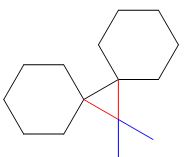
Explanation of Solution
The given reaction involves treatment of an alkene with
The treatment of
The corresponding reaction is shown below.

Figure 1
Thus, the product of the given reaction is,

Figure 2
The product of the given reaction is drawn in Figure 2.
(b)
Interpretation: The product formed in the given reaction is to be drawn.
Concept introduction: The treatment of an organic halide with an alkene in the presence of
Answer to Problem 26.34P
The product of the given reaction is,

Explanation of Solution
The given reaction involves treatment of an organic halide with an alkene in the presence of
The treatment of an organic halide with an alkene in the presence of
The corresponding reaction is shown below.

Figure 3
Thus, the product of the given reaction is,

Figure 4
The product of the given reaction is drawn in Figure 4.
(c)
Interpretation: The product formed in the given reaction is to be drawn.
Concept introduction: The treatment of an organic halide
Answer to Problem 26.34P
The product of the given reaction is,
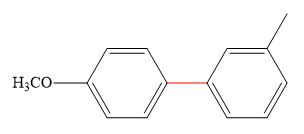
Explanation of Solution
The given reaction involves treatment of an organic halide with an organoborane reagent in the presence of
The treatment of an organic halide
The corresponding reaction is shown below.

Figure 5
Thus, the product of the given reaction is,

Figure 6
The product of the given reaction is drawn in Figure 6.
(d)
Interpretation: The product formed in the given reaction is to be drawn.
Concept introduction: The treatment of an organic halide
Answer to Problem 26.34P
The product of the given reaction is,

Explanation of Solution
The given reaction involves treatment of an organic halide with an organoborane reagent in the presence of
The treatment of an organic halide
The corresponding reaction is shown below.

Figure 7
Thus, the product of the given reaction is,

Figure 8
The product of the given reaction is drawn in Figure 8.
(e)
Interpretation: The product formed in the given reaction is to be drawn.
Concept introduction: The ring-closing metathesis (RCM) by Grubbs catalyst occurs, when the starting material is diene. This reaction is facilitated under high-dilution condition as it favors intramolecular metathesis instead of intermolecular metathesis.
Answer to Problem 26.34P
The product of the given reaction is,
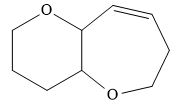
Explanation of Solution
The given reaction involves treatment of a diene with Grubbs catalyst.
The ring-closing metathesis (RCM) by Grubbs catalyst occurs, when the starting material is diene. This reaction is facilitated under high-dilution condition as it favors intramolecular metathesis instead of intermolecular metathesis.
The corresponding reaction is shown below.
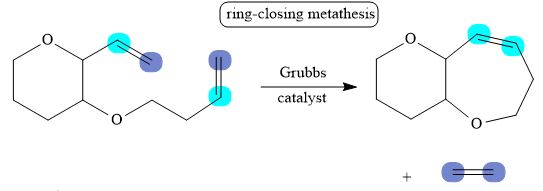
Figure 9
Thus, the product of the given reaction is,

Figure 10
The product of the given reaction is drawn in Figure 10.
(f)
Interpretation: The product formed in the given reaction is to be drawn.
Concept introduction: The nonhalogenated cyclopropanes are synthesized by the treatment of an alkene with
Answer to Problem 26.34P
The product of the given reaction is,
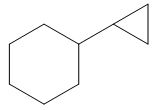
Explanation of Solution
The given reaction involves treatment of an alkene with
The nonhalogenated cyclopropanes are synthesized by the treatment of an alkene with
The corresponding reaction is shown below.

Figure 11
Thus, the product of the given reaction is,

Figure 12
The product of the given reaction is drawn in Figure 12.
(g)
Interpretation: The product formed in the given reaction is to be drawn.
Concept introduction: The treatment of an organic halide with
Answer to Problem 26.34P
The product of the given reaction is,
![]()
Explanation of Solution
The given reaction involves treatment of chlorobutane with
The treatment of an organic halide with
The corresponding reaction is shown below.

Figure 13
Thus, the product of the given reaction is,
![]()
Figure 14
The product of the given reaction is drawn in Figure 14.
(h)
Interpretation: The product formed in the given reaction is to be drawn.
Concept introduction: The treatment of an organic halide
Answer to Problem 26.34P
The product of the given reaction is,
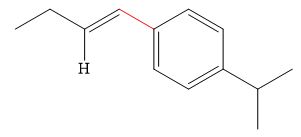
Explanation of Solution
The given reaction involves treatment of an alkyne with an vinylborane, followed by treatment with organic halide in the presence of
The treatment of given alkyne with catecholborane leads to the formation of corresponding vinylborane in first step. This vinylborane (an organoborane) is formed by hydroboration which adds
The treatment of an organic halide
The corresponding reaction is shown below.
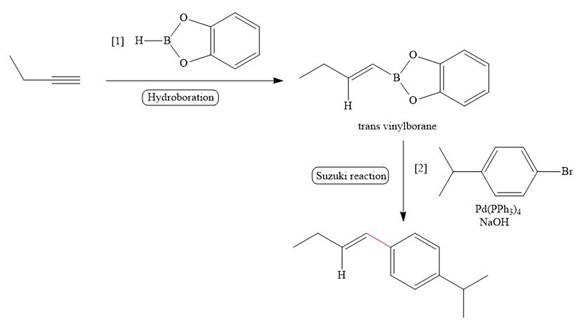
Figure 15
Thus, the product of the given reaction is,

Figure 16
The product of the given reaction is drawn in Figure 16.
Want to see more full solutions like this?
Chapter 26 Solutions
Package: Loose Leaf for Organic Chemistry with Biological Topics with Connect Access Card
Additional Science Textbook Solutions
Fundamentals of Anatomy & Physiology (11th Edition)
MARINE BIOLOGY
HUMAN ANATOMY
Loose Leaf For Integrated Principles Of Zoology
Organic Chemistry
Human Anatomy & Physiology (2nd Edition)
- is SiBr4 Silicon (IV) tetra Bromine? is KClO2 potassium dihypochlorite ?arrow_forward"יוון HO" Br CI Check the box under each structure in the table that is an enantiomer of the molecule shown below. If none of them are, check the none of the above box under the table. Molecule 1 Molecule 2 Molecule 3 Br Br Br HO OH H CI OH ✓ Molecule 4 Molecule 5 Molecule 6 CI Br יייון H Br OH OH CI Br ☐ none of the above × Garrow_forwardUS2 Would this be Uranium (II) diSulfide?arrow_forward
- nomenclature for PU(SO4)3arrow_forwardLi2CrO4 is this Lithium (II) Chromatearrow_forwardCheck the box under each structure in the table that is an enantiomer of the molecule shown below. If none of them are, check the none of the above box under the table. NH ** Molecule 1 NH Molecule 4 none of the above Х Molecule 3 Molecule 2 H N wwwwww.. HN Molecule 5 Molecule 6 HN R mw... N H ☐arrow_forward
- Nomenclature P4S3 Would this be tetraphsophorus tri sulfide?arrow_forwardDon't used Ai solutionarrow_forwardBenzene-toluene equilibrium is often approximated as αBT = 2.34. Generate the y-x diagram for this relative volatility. Also, generate the equilibrium data using Raoult’s law, and compare your results to these.arrow_forward
- Given the most probable macrostate: s/k (K) Populations 300 4 200 8 100 16 0 32 Indicate how to demonstrate that the population of the levels is consistent with the Boltzmann distribution.arrow_forwardRank the following components in order of decreasing volatility: butane, n-pentane, iso-pentene (e.g., 3-methyl-1-butene), isoprene, pentanol? Briefly explain your answer.arrow_forwardViscosity of a liquid related to the activation energy.arrow_forward
 ChemistryChemistryISBN:9781305957404Author:Steven S. Zumdahl, Susan A. Zumdahl, Donald J. DeCostePublisher:Cengage Learning
ChemistryChemistryISBN:9781305957404Author:Steven S. Zumdahl, Susan A. Zumdahl, Donald J. DeCostePublisher:Cengage Learning ChemistryChemistryISBN:9781259911156Author:Raymond Chang Dr., Jason Overby ProfessorPublisher:McGraw-Hill Education
ChemistryChemistryISBN:9781259911156Author:Raymond Chang Dr., Jason Overby ProfessorPublisher:McGraw-Hill Education Principles of Instrumental AnalysisChemistryISBN:9781305577213Author:Douglas A. Skoog, F. James Holler, Stanley R. CrouchPublisher:Cengage Learning
Principles of Instrumental AnalysisChemistryISBN:9781305577213Author:Douglas A. Skoog, F. James Holler, Stanley R. CrouchPublisher:Cengage Learning Organic ChemistryChemistryISBN:9780078021558Author:Janice Gorzynski Smith Dr.Publisher:McGraw-Hill Education
Organic ChemistryChemistryISBN:9780078021558Author:Janice Gorzynski Smith Dr.Publisher:McGraw-Hill Education Chemistry: Principles and ReactionsChemistryISBN:9781305079373Author:William L. Masterton, Cecile N. HurleyPublisher:Cengage Learning
Chemistry: Principles and ReactionsChemistryISBN:9781305079373Author:William L. Masterton, Cecile N. HurleyPublisher:Cengage Learning Elementary Principles of Chemical Processes, Bind...ChemistryISBN:9781118431221Author:Richard M. Felder, Ronald W. Rousseau, Lisa G. BullardPublisher:WILEY
Elementary Principles of Chemical Processes, Bind...ChemistryISBN:9781118431221Author:Richard M. Felder, Ronald W. Rousseau, Lisa G. BullardPublisher:WILEY





